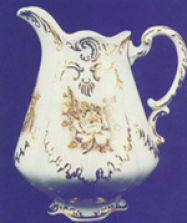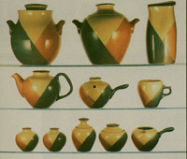The former partners in the inoperative East Liverpool Potteries Company assembled together on July 7, 1903 at the home of Robert Hall to settle and distribute the assets of the company. At this meeting Robert Hall accepted as his share ownership of the plant located on the S.E. corner of E. 4th St. and Walnut. This was the plant previously known as the West, Hardwick and George Pottery. Thirty eight days later, on August 14, 1903, he formed the Hall China Company. Three kilns were fired and 33 potters began work at the plant making bedpans and combinets (sic).earlyhall.JPG (19873 bytes)
The company had a slow start. It suffered from lack of capital and was in competition with more than 20 other small potteries.
Robert Hall was not to see the developments and successes of his fledgling company as he died in 1904 only a year after forming the company.
Management of the company was taken over by Robert Taggert Hall, the son of the founder. It was not long before he began investigating the possibility of developing a glaze that would withstand the extreme heat needed for a bisque firing. This process would make it possible to fire ware in one single firing. There was little to go on. The history books stated that it had been done in ancient China but the process and formulae had been lost.
Single Fire Process
From 1905-1911 Hall and his Superintendents experimented to develop the single fire process and also to keep the struggling company afloat. It was soon evident that the glaze would have to be lead free because it was the lead that could not withstand the high temperatures of the bisque firing kiln. During this period they produced combinets, bedpans, mugs and jugs. In 1908 they introduced dinnerware which was made in small quantities until 1914. Hall became associated at this time with Francis Simmers and the partnership between the two kept the pottery in business. Simmers kept the orders coming in. These were lean years and often the management had trouble meeting the payroll.
Disaster struck in 1910 when vandals entered the plant on Memorial Day and did over $3,000 worth of damage to equipment. This could have proved a catastrophic loss to the company but Hall became more determined to perfect his single fire process.
Early in 1911 they were to see the fruition of their efforts. The first successful lead-less glaze was mixed in a pestle and mortar and was just enough to cover half a mug. It was fired at 2,200*F. Results were good but not great. They mixed a larger batch and eventually did a full kiln of ware with the glaze. The ware in the hottest part of the kiln was perfect the other was not. It was determined to raise the temperature to 2,400*F and maintain the temperature throughout the firing process. When the kiln doors were opened they knew they had found the right combination of glaze and temperature. The ware was strong, hard, non-porous and craze-proof.
Simms loved the quality of the ware and vowed to sell so much that they would have to double his plant. Within a few months production had increased from 2 dozen pieces/day to 16 dozen pieces/day.
Growing Opportunities
In 1914 the company was faced with a great opportunity to establish themselves in the American market. W.W.I in Europe meant that ware could not be shipped or sold in the
U.S. Hall China put all its efforts into making casseroles, teapots, coffeepots, coffee urn liners and other ware used by restaurants and institutions. Hall Chinas reputation for the quality of its ware grew so much during this period that when the war was over, even when the cheaper European ware became available, the institutions did not buy it because it was less expensive over the long term to invest in the Hall ware. European ware was fragile, soft, porous, and absorbent with a rough finish. Hall ware was strong, smooth, non-porous, non-absorbent and glistened when new and was still so after extended use.
Expansion
With the combination of Hall and Simmers, now partners and sharing the presidency of the company, alternating a year at a time the fate of the company seemed assured.
In 1919 they purchased the Goodwin Pottery at E.6th St. and Broadway and started making gold-decorated teapots for the retail market. Hall was soon the largest producer of decorated teapots in the world.
In 1920 Robert Taggart Hall died from a heart attack and Simmers took full control of the company.
The company continued to expand. The research and development departments to this day work to improve the process and the ware. Early developments were under-glazes of various colors.
In 1927 a third plant was added producing soda-fountain jars and then in 1928 decorated cooking china to be sold on the retail market.
By 1929 it was obvious that it would be a wise move to consolidate the production of ware under one roof. Twenty three acres of land were purchased in the East End of East Liverpool. The new facility was 250 feet wide by 680 feet long, all on one floor, covering 170,000 square feet. The open plan allowed for continuous and progressive movement of the production. There were three tunnel kilns for firing. The plant saw as many as eight additions in the '30's and '40's as production boomed.
In 1933 Hall China produced decorated cooking china, teapots and coffee-pots. In 1936 they expanded the line again to include dinnerware.
 Today
Today
Recently joining Homer Laughlin China, Hall China continues its mission as the largest manufacturer of specialty dinnerware. It has adapted to the trends and growth of the market. A few years ago it had a line of ware for the Longaberger Company which they sell in conjunction with their baskets.
